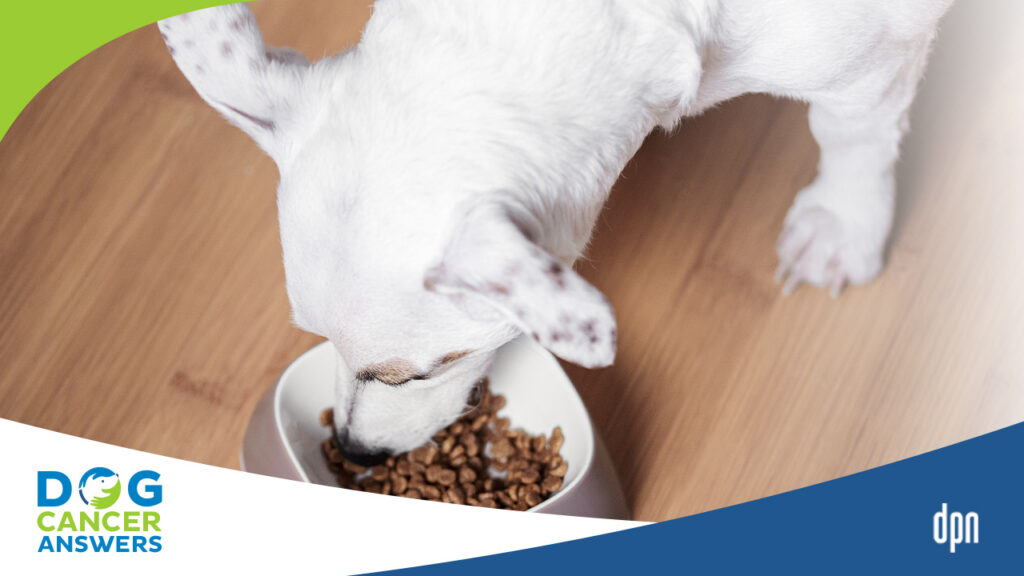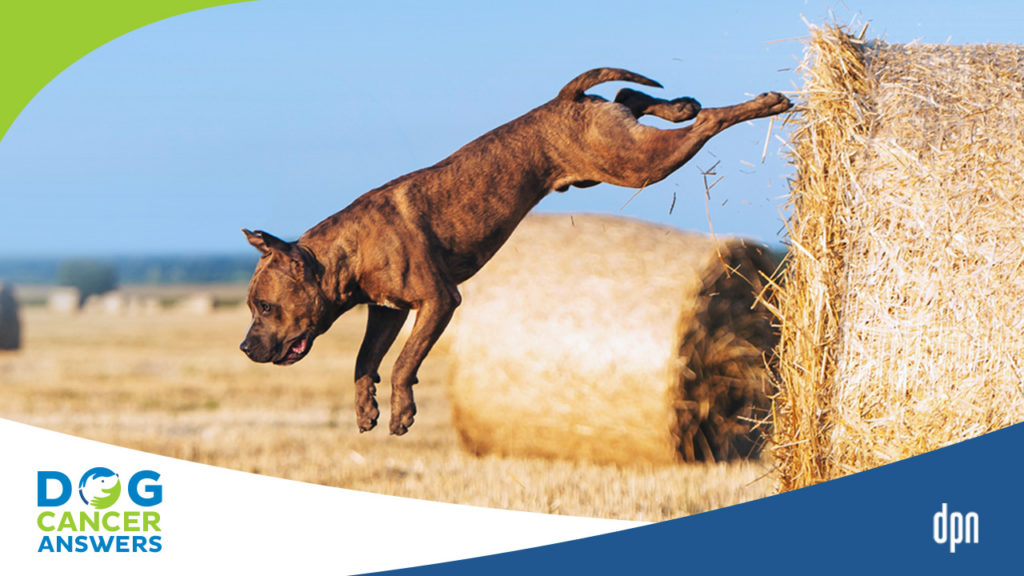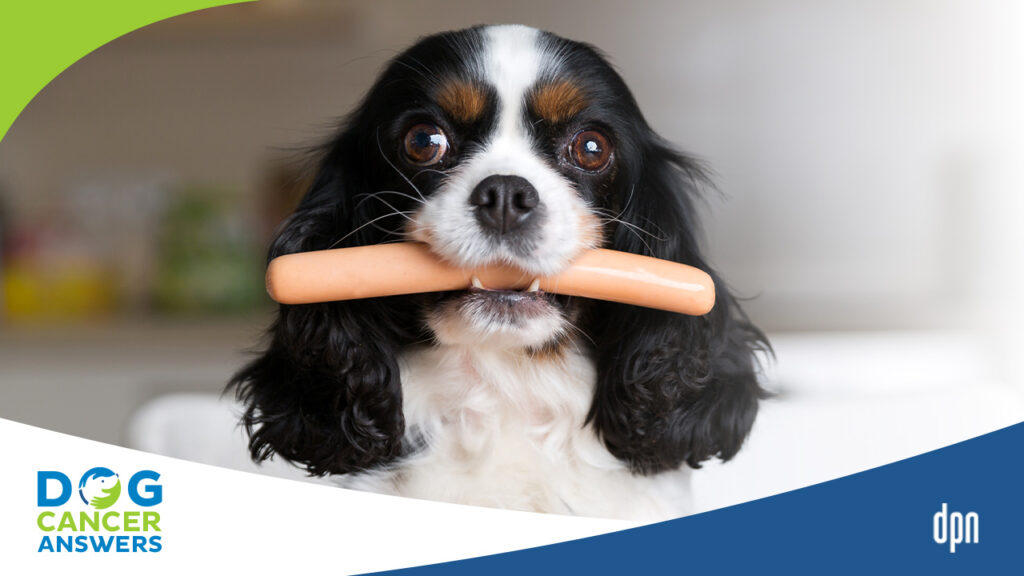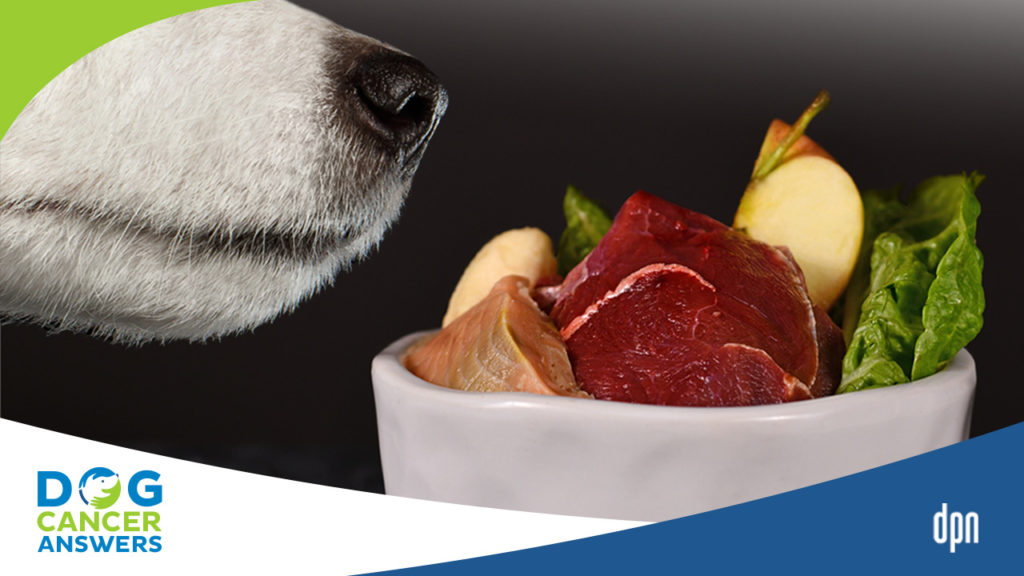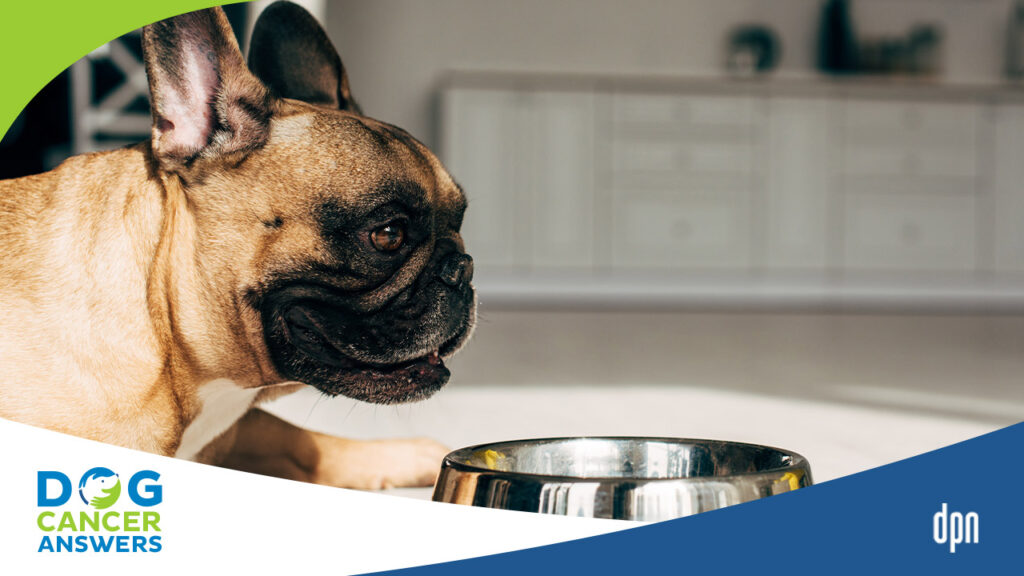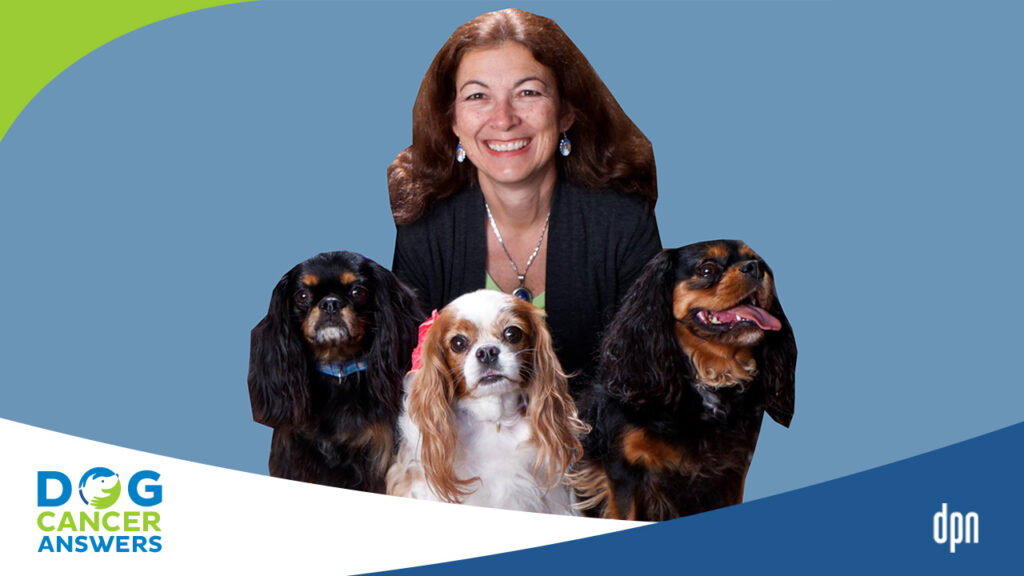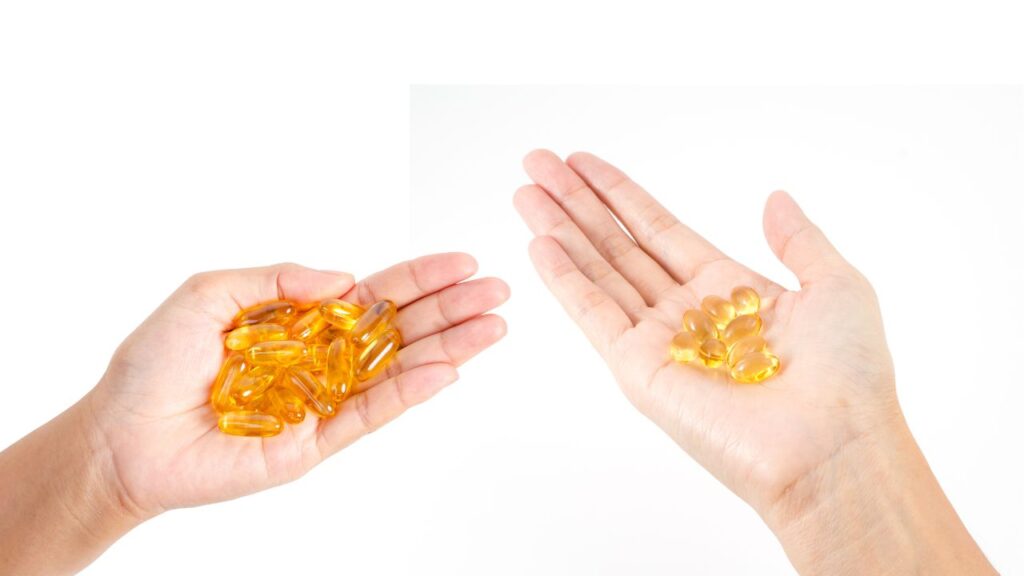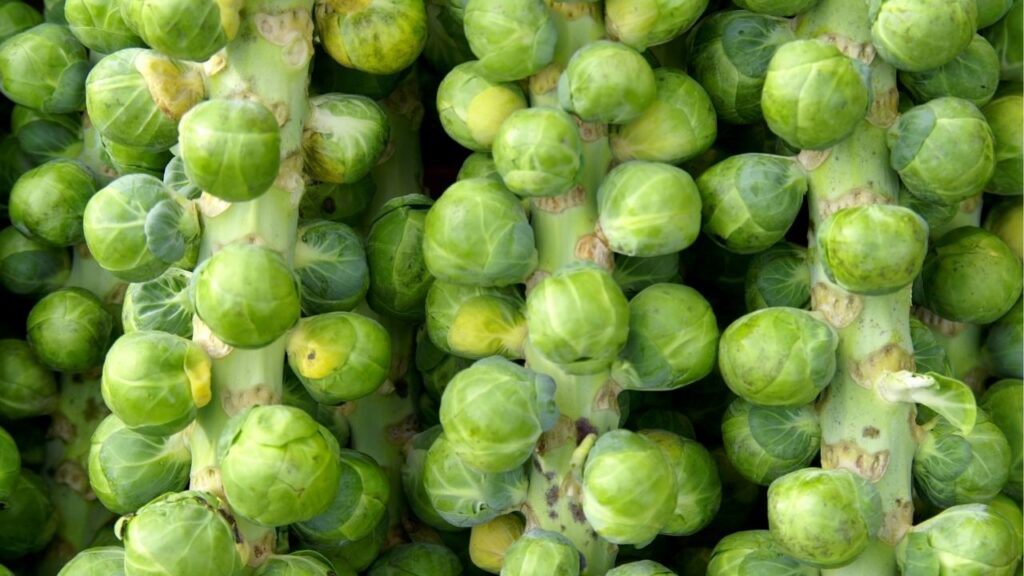While there is no one-size-fits all recipe for the perfect dog cancer diet, there are a number of easy steps you can take to give your dog a nutritional boost on his cancer journey.
Key Takeaways
- Lean proteins, cruciferous veggies, mushrooms, sardines, and berries are some great additions to a dog’s cancer-fighting diet
- Avoid excess starchy carbohydrates, corn and vegetable oils, grilled and broiled foods for dogs with cancer
- An ideal diet for most dogs with cancer is higher protein, moderate fat, and low carbohydrate – with the carbs coming from healthy vegetables and fruits for fiber and phytonutrients
- Cancer cells prefer glucose from carbohydrates, so limit carbs to take away their energy source
What Do Dogs with Cancer Need to Eat?
If your dog has cancer, we argue they need a complete and balanced diet more than ever. The ideal dog cancer diet is complete, balanced, and nutritious.
“Complete” means that the diet provides all of the nutrients your dog needs, and “balanced” means that the nutrients are provided in the correct amount – not too much or too little.
As for nutrition, let’s look at the official guidelines for dog diets established by the federal government in the U.S.
AAFCO Guidelines for Commercial Dog Diets
Almost all commercially available over-the-counter diets for dogs meet the minimum nutrition amount guidelines as established by the Association of American Feed Control Officials (AAFCO).1
Dog food manufacturers can meet these guidelines by either of these methods:
- Formulating the food to meet AAFCO nutrient profiles – this means the pet food company does the math when they create the recipe to make sure it aligns with AAFCO’s requirements for how much of each nutrient must be in the food, and/or they analyze the finished diet to confirm that it contains nutrient levels consistent with AAFCO’s requirements.
OR
- Performing feeding trials aligned with AAFCO’s guidelines. Feeding trial requirements for adult dog food state that at least eight dogs (up to two can be removed from the trial once it is underway) must be able to maintain their body weight and have no significant changes in four basic blood parameters during the six months of the trial.
Nutritional Adequacy Statements
Your dog’s food should have a “nutritional adequacy statement” on the label that indicates which of these two methods was used to determine that the food is complete and balanced for a specific life stage.
AAFCO recognizes growth (puppy), reproduction (pregnant and nursing female dogs), and adult life stages – and the nutrient requirements for dogs differ by which stage of life they are in. Feeding food formulated for your dog’s current life stage is important.
Enforcing Guidelines
While AAFCO lays out guidelines, it does not approve, certify, inspect, or regulate pet food. States determine independently whether to adopt as law and enforce these guidelines.
Companies can follow their nutritional profile guidelines, and the AAFCO nutritional adequacy statement on the label will tell you that the company has done so.
If you use a commercial diet, it is important to see those AAFCO statements, or you cannot be confident the food has the minimum nutritional profile set by AAFCO.
Veterinary nutritionist Dr. Lindsey Bullen explores the nuanced subject of how to feed a dog with cancer.
AAFCO Guidelines Are Minimums, Not Always “Ideals”
It’s also worth pointing out that AAFCO is giving us the minimum nutritional content guidelines, which may not be ideal for any one dog. Some dogs, with some conditions, might need more of certain nutrients than is included in AAFCO guidelines.
Throughout this article, you will hear us talk about consulting with a veterinary nutritionist for your dog’s dietary needs. That’s because, in the end, every dog’s needs may be varied enough that an expert is needed.
As is so often the case in dog cancer, there is no “one perfect diet” that meets the needs of every dog equally.
That said, let’s look at how cancer changes the dog’s body, and how nutrition may be able to help.
Cancer Diets Address Changes in Cancer Dogs
When your dog develops cancer, there are several changes in her body chemistry, physiology, and metabolism.2
- These changes can lead to cancer cachexia, which causes weight loss – not only excess body fat but also needed lean muscle mass.
- Cancer (and its treatments) can also cause a decrease in appetite, which further worsens this unwanted weight loss.
Between the weight loss from cancer, and not wanting to eat, it can be difficult to make sure she is getting all the nutrients she needs.3
Some veterinarians recommend changing food, maybe even a homecooked diet, to tempt dogs to eat more so their bodies stay strong while fighting cancer.
Does a Dog Cancer Diet Help?
Starting your dog on a dog cancer diet – whether that is a new commercial food, a homecooked diet, or something in between – is very common.
Veterinarians Aren’t Always Convinced
But not every veterinarian or veterinary oncologist thinks that a change in diet will help cancer enough to make it worth the research and planning.
They may also worry that dogs won’t like the new food, or will get gastrointestinal problems because of changes in diet.
Why rock the boat, when so many other treatments might help more?
Yet Studies Say Dog Lovers Want To Try a Dog Cancer Diet
The skeptical veterinarian’s attitude may be reasonable, and they may or may not be right about any individual dog.
However, many dog lovers don’t agree. They want something they can do at home to help their dog, and they have a long history of feeding their dog. It’s part of their relationship.
Because each dog is unique, and cancer affects individuals differently, every dog affected with cancer needs individualized nutritional interventions. Many dog parents recognize this and want to use nutrition to their dog’s benefit after a cancer diagnosis.
In one study of 75 dog guardians whose dog(s) had cancer, 90% changed their dog’s diet in response to the cancer diagnosis.3
Regardless of whether most veterinarians approve of a change in diet, dog lovers clearly want to try it.
Let’s look at some different approaches to diet that may be helpful to dog lovers who want to help improve their dog’s diet.
Commercial Dog Cancer Diet Options
In 2008 more than 90% of pet owners in the US and Australia fed their pets mostly or only commercial diets.5 Commercial diets are typically produced in mass quantities and are available in dry (kibble), canned, semi-moist, dehydrated, freeze-dried, or raw.
They offer convenience because many of these are processed and packaged for relatively long storage (either on the shelf or in the freezer).
Most of these diets adhere to AAFCO standard nutrient profile requirements, and because they are complete and balanced, they are often recommended after a cancer diagnosis.3
Many kibble and canned foods list a carbohydrate (corn/corn meal, wheat, or another flour) as the first ingredient. This is not ideal when feeding your dog with cancer.2 (More on that topic below.)
The One Commercial Food Designed for Dogs with Cancer
For those who don’t want to spend so much time cooking and thinking, there is one option for a commercial diet designed specifically for dogs with cancer. Hill’s, the pet food company, has entered this void twice.
In 1998, Hill’s released Prescription Diet n/d (for “neoplasia diet”) that was designed for dogs with cancer – the first commercial product specifically for this purpose. It was discontinued for a while, but Hill’s is releasing a new product – Prescription Diet ONC Care (“oncology care”) to fill this void.
It is available in the U.S. as of March 2023 and will be globally in 2024.
Hill’s says their new ONC Care diet includes highly digestible proteins and high levels of essential amino acids, along with prebiotics to support the microbiome as an assist for the digestive upset that can occur with cancer and its treatment.8
Homemade Dog Cancer Diets
Homemade diets offer flexibility and total control over what goes in your dog’s body, using fresh, whole food ingredients – so they often taste better to your dog, too, which may help to stoke her appetite.
That alone can help counter cachexia and increase your dog’s quality of life.
Many people whose dogs have cancer report making their dogs’ food at home, whether cooked, raw, or in some combination.3
However, when homemade diets come from untested sources (social media, word-of-mouth, or with no recipe), they can easily be unbalanced and/or incomplete, resulting in nutritional deficiencies or excesses that can lead to health complications.5
Possible Cancer Link?
One influential study has swayed some in the veterinary community to skepticism about homemade diets. It evaluated dietary factors in 86 healthy female dogs and 102 dogs with mammary cancer. The study found that 67% of the total caloric intake of dogs with cancer came from homemade foods, compared to 33% in healthy dogs.
That does sound very bad for homemade diets. However, the study also noted that a higher percentage of dietary fat was also correlated with a higher incidence of tumors and dysplasias.
Was the issue the homemade diets (which included dogs receiving table scraps and treats), or the overall nutrient deficiencies in the diet? 6
This study shows that if you are using a homemade diet, you should be sure that it is nutritionally balanced for your dog’s age, activity levels, other health conditions, and cancer. We will get into the details now.
Cancer Metabolism
Cancer cells metabolize differently than healthy cells. The raw materials you give your dog’s body (in the form of food) impact cancer’s metabolism and how well his body can weather the storm.2,7
As you have probably already discovered, many dietary strategies are proposed for dogs with cancer. These include low-carbohydrate diets, keto diets, grain-free diets, raw food, and dietary supplementation with omega-3 fatty acids.1,2
Overall, evidence shows that diets low in simple carbohydrates with moderate amounts of protein, fiber, and fats (emphasizing optimal omega-3 fatty acids levels) benefit dogs with cancer. 7
Let’s look at some of these items in more detail.
Carbs and Cancer
All cells in the body need an energy source to do their jobs, repair damage, grow, and reproduce.
Carbohydrates provide glucose, an immediately available energy source. If not immediately needed, glucose is stored as glycogen for later use.
Fat in the diet also provides an energy source for cells, in the form of ketone bodies.
In many types of cancer, the cancerous cells cannot use ketone bodies as fuel, so they rely exclusively on glucose.
The Warburg Effect
Cancer cells exhibit what is called the Warburg effect: they need even more glucose than normal cells, so they “burn” through it quickly.
Cancer cells use a different metabolic pathway than normal cells use, and this results in excess production of an acid called lactate.9
The buildup of lactate makes the environment even more favorable for cancer to grow and less favorable for the immune system to knock it out.10
This is why we generally recommend limiting carbs for your dog. Limiting the amount of carbohydrates in your dog’s diet could reduce the fuel source cancer needs, and help your dog’s body better fight the cancer.
Please note that “starve the cancer cells” is a common phrase, but it’s overblown. It’s not accurate that cancer cells will be completely deprived of food if you limit carbohydrates. It will reduce their fuel, but not necessarily “starve” them.
Reducing the amount of fuel your dog’s cancer cells want is good, but trying to go all the way to zero with carbs is not good. Your dog’s healthy cells need carbs, too.
How Many Carbs Are Good for Dogs?
Dog lovers often wonder how many carbs dogs should have when healthy, let alone when they have cancer.
What do we know about this? Not as much as you might assume!
The National Research Council determines the nutrition guidelines upon which AAFCO’s nutrient profiles are based. As we mentioned above, AAFCO requires commercial dog foods to have a guaranteed minimum amount of protein, a minimum amount of fat, a maximum amount of fiber, and a maximum amount of moisture.11
Notice that they have established minimum amounts of proteins necessary for health in dogs, but they have not established any carbohydrate requirement for dogs. Instead, they establish a maximum amount of fiber.11
High-fiber foods are sometimes relatively low in carbohydrates, though. This lack of mandatory carbohydrate reporting on dog food labels can make us wonder how many carbohydrates are in our dog’s commercial foods. This lack of reporting may be one reason dog lovers so often want to feed a homecooked diet to their dogs with cancer.
Both the research on dietary carbohydrate needs and dogs’ own preferences make clear that dogs do not need or desire high carbohydrate levels in their food.
But Don’t Dogs Love Carbs?
What do dogs themselves think about carbohydrates? We happen to have a study that reveals a little bit about that.
In one 10-day study, researchers allowed 15 dogs to self-select their preferred diet among three choices, all of which met AAFCO guidelines:
- a high-protein diet
- a high-fat diet
- a high-carbohydrate diet
The dogs both first approached and consumed the high-protein diet most often: 64% of the time.12
In contrast, they approached and consumed the high-carbohydrate diet least often: only 4% of the time.12
This is quite striking, isn’t it? Dogs in the study clearly preferred a high-protein diet to a high-carb diet.
So, between the research on dietary needs for carbs and the dogs’ preferences, there is neither a need nor a desire for high carbohydrate levels in dog food.
Don’t worry, dogs will still get carbs in even the healthiest of foods.
Nutrition expert and veterinarian Dr. Susan Recker reveals the BEST and WORST foods for dogs with cancer.
Here are Some Foods that “Fight Cancer”
For example, your dog can get good carbohydrates from vegetables. Vegetables have fiber or roughage, which is a must, and phytonutrients (plant nutrition). Some vegetables have more carbohydrates than others, especially those high in starch.
Others lower in starch and packed with nutritional value might be better for dogs with cancer. For example, cruciferous vegetables are great for dogs with cancer, not just because they are relatively low-carb.
Brassica Vegetables
Vegetables from the Brassica genus, like cauliflower, broccoli, and Brussels sprouts, are nutritional powerhouses for dogs with cancer because they contain over 200 glucosinolates.
Sulforaphane, benzyl isothiocyanate, and phenethyl isothiocyanate are three of the glucosinolates that have been widely studied across several cell types.
These compounds have been shown to both inhibit the growth of cancer cells and make drug-resistant cancer cells more sensitive to chemotherapy.13
Omega-3 Fatty Acids
Another addition that is widely viewed as beneficial in the diet of dogs with cancer is polyunsaturated n-3 fatty acids or omega-3s.
In one study, 32 dogs with lymphoma received a diet supplemented with fish oil (a source of omega-3s) or a control diet with soybean oil.
Dogs fed the experimental diet had significantly higher levels of n-3 fatty acids, and increasing n-3 fatty acid levels in blood were significantly associated with longer survival times and disease-free intervals.14
Leaner Meats
In the study mentioned above that looked at dietary factors in female dogs with mammary cancer, there was a negative correlation with chicken in the diet: 6
- A higher intake of red meat (less chicken) was associated with mammary cancer development.
- A higher intake of chicken (less red meat) was associated with fewer cases of mammary cancer.
The balance of omega-3 fatty acids and omega-6 fatty acids may play a role in this association.
Factory-farmed animals tend to have higher levels of omega-6 fatty acids, which may be less healthy for dogs with cancer.
Leaner meats tend to have less fat, and, therefore, less omega-6 fatty acids.
Cooking and Nutrients
Cooking affects some nutrients, including those beneficial isothiocyanates in cruciferous veggies, like cauliflower.13
Boiling and blanching, in particular, may result in loss of protein and minerals, as well as phytonutrients. However, steaming, stir-frying, and microwaving minimize these losses in cauliflower.15
Generally, cooking foods by microwave causes minimal loss of protein, fat, and mineral content. In one study, vitamin loss through microwaving was similar to that of conventional cooking.16
But another study that looked at ten different vegetables prepared by four different cooking methods found that the degree of vitamin loss was not consistent among vegetables for any cooking method. In fact, some vegetables had higher vitamin content available after certain types of cooking. So, the effect of cooking on vegetables can be quite variable.17
We may not know enough about how specific foods react to specific cooking methods to make concrete recommendations about how to cook every ingredient you give your dog.
The main advice we must give about the cooking method is temperature. You want to avoid high-heat cooking (see below).
Cooking and Digestibility
To complicate things further, even though some foods may have higher nutrient content in their raw state, those nutrients might not be readily available to dogs because they are “locked” in a relatively undigestible food. Cooking these foods may be the key to unlocking those nutrients.
For example, vegetables and mushrooms contain cellulose (fiber) in their cell walls. Herbivores make the enzyme necessary to break down that cellulose to access the nutrients in the plant cells, but omnivores and carnivores don’t.
By cooking vegetables and mushrooms for your dog, you can make them more easily digestible, which helps your dog absorb more nutrients.
For example, chicken necks, full of small bones, are an excellent source of calcium and phosphorus, and dogs love them. Drs. Demian Dressler and Susan Ettinger, authors of The Dog Cancer Survival Guide, recommend cooking necks until the bones are soft and malleable. (Don’t stop cooking too early, when they are in the brittle stage – that’s when they can break into sharp pieces that can be dangerous). Then mash the necks and remove any pieces large enough to find, to minimize choking risk. The tiny pieces of softened bone left in the mash are mineral-rich and easy to digest.2
Cooking Temperatures and Carcinogens
Cooking temperatures are an important factor in the safety of your dog’s food, so let’s look at those next.
Heterocyclic amines are compounds formed when meat is cooked at high temperatures. These compounds have been associated with cancer in animals and primates.18
Traditional methods of cooking meat, such as grilling, smoking, and roasting, can cause heterocyclic amines and another carcinogenic compound, acrylamides, to develop.
Microwaving, steam roasting, or infrared grilling are better options for retaining nutrients while not introducing carcinogens.19
Concern over the formation of carcinogens during cooking and the high-heat processing involved in manufacturing kibble and canned foods has contributed to interest in raw meat-based diets for dogs.20
But cooking is still a safe option if it’s done at lower temperatures. Drs. Dressler and Ettinger recommend cooking low and slow because almost no carcinogens are formed at 212°F, but over 390°F, there is increased risk.2
So if you cook for your dog, stick to cooking at lower temperatures to minimize their production: simmer, cook in a crock pot or slow cooker, or use a pressure cooker or instant pot.2
Cooked vs. Raw?
Raw meat-based diets might be an excellent choice for healthy dogs with healthy immune systems.
But dogs battling cancer may have significant immune system compromise – from both cancer itself, and some of the cancer treatments – that leaves them unable to fend off potentially dangerous bacteria (like E. coli or Salmonella) or parasites that can be found in raw meat.2
Even freezing and freeze-drying doesn’t necessarily mitigate this risk enough to make these diets the best bet for dogs with cancer.20
Is There a Definitive Home-Cooked “Dog Cancer Diet?”
There are no defined nutrient profiles specific to dogs with cancer at this time, so there is not one accepted “dog cancer diet.”
Your dog’s best dog cancer diet is one your dog will eat that meets all nutrient requirements.
It should also offer enough flexibility to use ingredients that address your dog’s changing needs and preferences as he progresses.2
Every dog – and their cancer – is different.
For example, mast cell tumors release histamine, which can create swelling, blood pressure changes, vomiting, and loss of appetite. Some foods, like tofu, yogurt, and shellfish, are either high in histamine themselves or trigger the release of histamine in your dog’s body. These would be on the “foods to avoid” list for dogs with mast cell tumors. But they could be fine additions to the diet for a dog with a different type of cancer.20
You can arrive at the ideal diet plan for your dog with cancer by working with a board-certified veterinary nutritionist who can provide valuable information, formulate a diet specific to your dog’s needs, and monitor their response to dietary changes.3
Rough Macronutrient Guidelines
It can be hard to get a home diet right – it may not be nutritionally adequate on its own, especially if you aren’t using a recipe formulated by a nutritionist or not following it exactly.
In a study investigating 27 home-prepared recipes, none met the AAFCO or NRC Recommended Amounts for all essential nutrients.1
Protein and Fat Guidelines
AAFCO minimums are 18% protein and 5% fat for adult dogs, with no carbohydrate requirement.
But these are minimums, not necessarily ideal proportions.
Higher protein (closer to 40%) and moderate fat (about 15-20%), along with low-carb vegetables (and some fruits) to provide fiber and phytonutrients, maybe a better target.
Healthy whole grains such as brown rice and oatmeal may round out the diet, especially for dogs with cancer who may have trouble maintaining their weight, as these can be a nutritious source of additional nutrients and calories.
Multivitamins
Multi-vitamins are commonly used to help “fill in the gaps” that may be present in home-prepared diets. But do not blindly over-supplement – some vitamins have established safe upper limits. And some dogs can’t tolerate high doses of certain minerals, even if there is no accepted maximum recommended amount.
For example, excess copper has been tied to liver disease in dogs.21 How much copper is too much? Well, there is no defined upper limit. But since this is a problem, don’t supplement copper if your dog’s diet already meets the minimum nutritional requirement for copper.
Especially if you use a highly-supplemented commercial diet for part of your dog’s daily ration, be aware of what is in his food, and don’t use an extra supplement without guidance. Work with your veterinarian and veterinary nutritionist to ensure your dog’s diet meets all his nutritional targets.
Specific Foods to Include
Some foods are worth including regularly in your dog’s diet, especially if she has cancer. Some of these can be added on top of a commercial diet, for example:
- As noted above, vegetables from the Brassicaceae family (cauliflower, broccoli, Brussels sprouts) are especially well-known and effective because they have several bioactive phytochemicals that help prevent and treat cancer.22,23
- Mushrooms have beta-glucans (β-glucan) in their cell walls that work to stimulate lymphocytes, a big player in immune function.2
- Some especially great mushroom choices are the “medicinal mushrooms”: Reishi (Canoderma lingzhi), Maitake (Grifola frondosa), Shiitake (Lentinula edodes), and Turkey Tail (Coriolus versicolor)
- Proteins:
- Chicken is a great source of protein, including some specific amino acids, vitamins, and minerals.
- Beef is also a rich source of protein and other nutrients, but it is not the best protein option for dogs with mammary (breast) cancer.2 As above, high beef intake and low chicken intake have been associated with mammary tumors.6
- Other sources include fish (although not a good choice for mast cell tumors), turkey, venison, duck, pork, goat, and lamb.
- You may also wish to include cottage cheese, oatmeal, virgin coconut oil, brown rice, raspberries, sardines, leafy herbs (parsley, basil), garlic in small amounts, and ginger root.2
Drs. Dressler and Ettinger recommend these meal-time guidelines:
- High-quality lean protein – full of amino acids, vitamins, and minerals, and helps maintain muscle mass
- Fats and oils – healthy fat is good fat. Fish oil and krill oil are great sources of omega-3 fatty acids, which often need a boost in the diet to balance the often excessive – and pro-inflammatory at high levels – omega-6 fatty acids (chicken is high in omega-6s).
- Vegetables – brighter colored vegetables tend to be higher in cancer-fighting phytonutrients.
- Chicken necks are a great whole food source of important minerals like calcium and phosphorus.
- Whole grains – a healthy source of carbohydrate energy. Brown rice and oatmeal are good examples.
- A multivitamin – this can help to provide missing elements in your dog’s homemade diet (so it’s important to know what is present and what is missing)
- Healthy additions of toppers and treats: Add flavor to your dog’s meal while sneaking in immune-boosting and cancer-fighting components – fresh garlic, basil, virgin coconut oil, and fresh blueberries are a few examples.
Dr. Sue Ettinger, veterinary oncologist AKA Dr. Sue Cancer Vet, talks about the "perfect diet" for dogs with cancer. Hint: don't drive yourself crazy!
How Much Should I Feed My Dog?
If you have used commercial diets until now to feed your dog, you are used to seeing instructions on how many cups or ounces of food to give your dog based on their weight.
However, this is not the best way to decide how much to feed a dog. Dogs are highly variable, just like humans are. A couch potato needs less food than an athlete, just like humans.
Dogs with cancer are highly variable, and so is the amount of food they need. Remember that over-feeding is never healthy, and obesity can contribute to cancer.2
Obesity at one year of age and one year before their cancer diagnosis significantly correlated to the prevalence of mammary tumors in female dogs.6
When a nutritionist formulates a recipe, they should provide feeding guidelines for your dog, based on her age, activity level, current weight and body condition, and metabolic needs. Feeding more or less than the recipe was formulated to deliver can result in vitamin or mineral excesses (which could be toxic) or deficiencies (which doesn’t give your dog what her body needs to function).
Your regular veterinarian can also advise you about how much your dog should weigh. If your dog is overweight, feeding a little less of their diet can help them to take off weight, for example.
Change Diet Slowly
If you are transitioning your dog from his previous diet to a cancer-fighting diet, whether homemade or commercial, do so gradually enough to allow his system to acclimate, usually over two weeks.2
Hybrid Dog Cancer Diets
If switching to a homemade diet seems overwhelming or impractical, fear not – your dog can reap the benefits of some cancer-fighting superfoods in addition to her regular commercial diet.
In a study where 75 owners whose dogs had cancer were interviewed, 18% used a combination of conventional and homemade diets.3
There are several ways this can look. A few options include:
- If your dog eats twice daily, 1 or 2 meals out of the 14 meals per week are homemade.
- You could make 25-50% of your dog’s bowl at every meal fresh food mixed with her commercial diet, as long as this is complete and balanced (rely on a nutritionist to help you determine this).
- You could add healthy treats or meal toppers to her entirely commercial meals. Anecdotal evidence and testimonies from owners of dogs with cancer show that positive outcomes can be observed when toppers are added to commercial food diets.2
- These toppings can add flavor, immune-boosting, and cancer-fighting properties,2 so choose wisely – select foods with benefits.
- The general rule of thumb is no more than 10% of the total diet should be treats and/or toppers, to avoid disrupting the overall balance.
- Avoid overloading any individual vitamins or minerals – too much of a good thing can sometimes be bad.
- If you are using a commercial food base, know whether any nutrients are approaching safe upper limits, so you don’t inadvertently add more of this nutrient to the bowl. You will likely need to call the manufacturer to get this information.
Dogs with Multiple Health Conditions
Your dog may have preexisting conditions (or develop other conditions after cancer diagnosis) that will impact many aspects of their cancer treatment, including diet. Some common examples are:
- Kidney disease:
- Avoid dry kibble. In the face of kidney disease, dogs lose more fluid through their urine, and fresh foods containing moisture can contribute to hydration.
- Avoid foods that are high in phosphorus – foods like jerky, sardines, bread, beans, nuts, organ meats, and many “regular” dog foods. Phosphorus restriction is accepted as the most critical dietary intervention for dogs with kidney disease.24
- A protein-restricted diet may be suggested, but this is controversial as studies have not consistently demonstrated the same benefits as phosphorus restriction.24
- Pancreatitis:
- Avoid high-fat diets, as they have been associated with pancreatitis.25
- If your dog does develop pancreatitis, he will likely need to remain on a low-fat diet for life.
- Choosing very lean meats is important, so leave the skin off poultry and choose 90% lean (or leaner) ground meats.
- Dogs that have pancreatitis and cancer may not benefit from a high-fat diet (e.g., keto).
- Allergies:
- Your dog could be allergic to any number of things (just as people can). Monitor your dog when trying anything new, and avoid foods your dog has already reacted negatively to. For example, krill oil is not a safe choice if your dog has a shellfish allergy, but there are plenty of other food sources rich in omega-3 fatty acids, such as salmon or other fatty fish, or flax seeds.2
Choosing Between Other Health Conditions and Dog Cancer Diet
Many dog lovers panic when their dog with cancer develops kidney problems and needs a kidney-friendly diet, or pancreatitis that requires a pancreas-friendly diet, or new allergies that require a different diet. They worry that feeding their dog a non-dog cancer diet will be harmful and let the cancer progress.
We always have to weigh the pros and cons in treating any illness, which is tricky.
In general, the best choice is to modify the diet to accommodate the non-cancer condition, because they can kill a dog faster than cancer usually does.
- Pancreatitis can be deadly, resulting in death within a few days.
- Kidney and liver failure generally kill dogs much quicker than cancer does.
- Allergies might not kill a dog, but they make them miserable.
Your veterinarian will be able to explain to you the timelines involved in each of your dog’s health issues, to help you understand why dietary modifications away from cancer-fighting foods and towards foods that support organs will help your dog.
You can also focus on foods generally “safe,” used commonly, and can help your dog with cancer and other conditions. For example, omega-3 fatty acids are part of the management plan for cancer, kidney disease, and allergies.2
Eating Something Is Better Than Nothing
The bottom line for feeding your dog with cancer is that eating something is better than not eating anything at all.2
If your dog doesn’t eat the masterfully crafted (complete and balanced) diet full of cancer-fighting superfoods that you offer him, know that even small improvements in diet can make a big difference.
You don’t have to feed the “perfect” diet to create positive changes.
Generally, diets that are low in simple carbohydrates and have moderate amounts of protein, fiber, and fats (with a special emphasis on omega-3 fatty acids) benefit dogs with cancer.7 The closer you can get to these parameters, the better.
Pick a few things you can do with your dog’s diet, and only make changes as your dog’s willingness, appetite, and your own budget and patience will allow. Food is fun for most dogs, so keep it that way.
Don’t try to be perfect, just try to improve. Enjoy mealtimes with your dog.
- Heinze CR, Gomez FC, Freeman LM. Assessment of commercial diets and recipes for home-prepared diets recommended for dogs with cancer. J Am Vet Med Assoc. 2012;241(11):1453-1460. doi:10.2460/javma.241.11.1453
- Dressler, D. and Ettinger, S. (2011) The dog cancer survival guide: Full spectrum treatments to optimize your dog’s life quality and longevity. Maui, HI: Maui Media, LLC.
- Rajagopaul, S. et al. (2016) Owners’ attitudes and practices regarding nutrition of dogs diagnosed with cancer presenting at a referral oncology service in Ontario, Canada, The Journal of small animal practice. U.S. National Library of Medicine. Available at: https://pubmed.ncbi.nlm.nih.gov/27357412/ (Accessed: January 29, 2023).
- Sanderson, S.L. (2022) Dog and cat foods – management and Nutrition, MSD Veterinary Manual. MSD Veterinary Manual. Available at: https://www.msdvetmanual.com/management-and-nutrition/nutrition-small-animals/dog-and-cat-foods (Accessed: January 29, 2023).
- Laflamme, D.P. et al. (2008) Pet feeding practices of dog and cat owners in the United States and Australia, AVMA. American Veterinary Medical Association. Available at: https://avmajournals.avma.org/view/journals/javma/232/5/javma.232.5.687.xml?rskey=MZHo8q&result=4 (Accessed: January 29, 2023).
- Pérez Alenza D, Rutteman GR, Peña L, Beynen AC, Cuesta P. Relation between habitual diet and canine mammary tumors in a case-control study. J Vet Intern Med. 1998;12(3):132-139. doi:10.1111/j.1939-1676. 1998.tb02108.x
- Ogilvie GK. Interventional nutrition for the cancer patient. Clin Tech Small Anim Pract. 1998;13(4):224-231. doi:10.1016/S1096-2867(98)80007-8
- Guiden M. Hill’s Pet Nutrition unveils Onc Care, therapeutic food formulated for pets living with cancer. Veterinary 33. https://www.veterinary33.com/companion-animals/products/1227/hill-s-pet-nutrition-unveils-onc-care-therapeutic-food-formulated-for-pets-living-with-cancer.html. Published January 13, 2023. Accessed January 29, 2023.
- Elisia I, Krystal G. The Pros and cons of low carbohydrate and ketogenic diets in the prevention and treatment of cancer. Frontiers. https://www.frontiersin.org/articles/10.3389/fnut.2021.634845/full. Published February 5, 2021. Accessed January 29, 2023.
- Pérez-Tomás R, Pérez-Guillén I. Lactate in the Tumor Microenvironment: An Essential Molecule in Cancer Progression and Treatment. Cancers (Basel). 2020;12(11):3244. Published 2020 Nov 3. doi:10.3390/cancers12113244
- Reading labels (2023) AAFCO. Association of American Feed Control Officials. Available at: https://www.aafco.org/consumers/understanding-pet-food/reading-labels/#guarantees (Accessed: April 26, 2023).
- Roberts MT, Bermingham EN, Cave NJ, Young W, McKenzie CM, Thomas DG. Macronutrient intake of dogs, self‐selecting diets varying in … Journal of Animal Physiology and Animal Nutrition. https://onlinelibrary.wiley.com/doi/10.1111/jpn.12794. Published October 12, 2017. Accessed January 30, 2023.
- Soundararajan P, Kim JS. Anti-Carcinogenic Glucosinolates in Cruciferous Vegetables and Their Antagonistic Effects on Prevention of Cancers. Molecules. 2018;23(11):2983. Published 2018 Nov 15. doi:10.3390/molecules23112983
- Ogilvie GK, Fettman MJ, Mallinckrodt CH, et al. Effect of fish oil, arginine, and doxorubicin chemotherapy on remission and survival time for dogs with lymphoma – a double-blind, randomized placebo-controlled study. Am Cancer Soc 2000;88(8):1916-1928. https://acsjournals.onlinelibrary.wiley.com/doi/pdfdirect/10.1002/(SICI)1097-0142(20000415)88:8%3C1916::AID-CNCR22%3E3.0.CO;2-F.
- Ahmed FA, Ali RF. Bioactive compounds and antioxidant activity of fresh and processed white cauliflower. Biomed Res Int. 2013;2013:367819. doi:10.1155/2013/367819
- Cross GW, Fung DYC, Decareau RV. The effect of microwaves on nutrient values of foods. CRC Critical Reviews in Food Science and Nutrition 1982;16(4):355-381. https://www.tandfonline.com/doi/abs/10.1080/10408398209527340?journalCode=bfsn19
- Lee S, Choi Y, Jeong HS, Lee J, Sung J. Effect of different cooking methods on the content of vitamins and true retention in selected vegetables. Food Sci Biotechnol. 2017;27(2):333-342. Published 2017 Dec 12. doi:10.1007/s10068-017-0281-1
- Sugimura T, Wakabayashi K, Nakagama H, Nagao M. Heterocyclic amines: Mutagens/carcinogens produced during cooking of meat and fish. Cancer Sci. 2004;95(4):290-299. doi:10.1111/j.1349-7006.2004.tb03205.x
- Suleman R, Wang Z, Aadil RM, Hui T, Hopkins DL, Zhang D. Effect of cooking on the nutritive quality, sensory properties and safety of lamb meat: current challenges and future prospects, Meat Sci 2020;167:108172. https://www.sciencedirect.com/science/article/pii/S0309174019309088?casa_token=G2fvjxpVEgoAAAAA:jyHv7g47dCh4rXhLZ5d870NztXI6BkllhZrc0CrMsGQdp-CJQ24kW8QgstY3fIlLLRD8RivexUI
- Freeman LM, Chandler ML, Hamper BA, Weeth LP. Current knowledge about the risks and benefits of raw meat-based diets for dogs and cats. J Am Vet Med Assoc. 2013;243(11):1549-1558. doi:10.2460/javma.243.11.1549
- Cornell University. The looming concern about copper in dog food: Copper overload is quietly killing our dogs. Cornell University College of Veterinary Medicine. https://www.vet.cornell.edu/news/20220128/looming-concern-about-copper-dog-food-copper-overload-quietly-killing-our-dogs. Published February 2022. Accessed January 30, 2023.
- Keck AS, Finley JW. Cruciferous vegetables: cancer protective mechanisms of glucosinolate hydrolysis products and selenium. Integr Cancer Ther. 2004;3(1):5-12. doi:10.1177/1534735403261831
- Ahmed FA, Ali RF. Bioactive compounds and antioxidant activity of fresh and processed white cauliflower. Biomed Res Int. 2013;2013:367819. doi:10.1155/2013/367819
- Cline MG. Nutritional management of chronic kidney disease in Cats & Dogs. Today’s Veterinary Practice. Published February 17, 2016. Accessed December 5, 2022. https://todaysveterinarypractice.com/nutrition/acvn-nutrition-notesnutritional-management-of-chronic-kidney-disease-in-cats-dogs/.
- Hess RS, Saunders HM, Van Winkle TJ, Shofer FS, Washabau RJ. Clinical, clinicopathologic, radiographic, and ultrasonographic abnormalities in dogs with fatal acute pancreatitis: 70 cases (1986-1995). J Am Vet Med Assoc. 1998;213(5):665-670.
Topics
Did You Find This Helpful? Share It with Your Pack!
Use the buttons to share what you learned on social media, download a PDF, print this out, or email it to your veterinarian.
